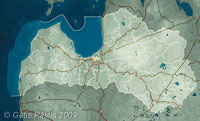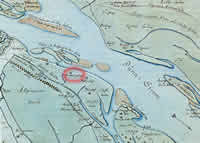
| Coordinates: | 56°58'07,12'' N
24°06'03,66'' E
Google Maps (localisation not exact, possible mistake up to 50 metres) |
| No: | 119 (list of all monuments) |
| Category: | Palaces and manor houses |
| Address: | Riga, Petersala-Andrejsala, in Petersala, near Katrinas dambis 8 |
| Versions of name: | Hermelingshof |
| Year of construction: | 18th c.? |
| Condition: | Does not exist |
| Value: | Architecture |
Hermeling manor is old chivalry manor which at the end of 18th century became a centre of manufacture. Manor house has not been preserved.
History
Master of Livonian order Gotthard Kettler allocated rights of chivalry manor to Hermeling manor and granted it to his supporters brethren Sieberg. Status of chivalry manor was retained by this manor up to the beginning of 20th century.
In 17th century this manor belonged to pastor H.Hermeling - his family name gave a name to manor. Hermeling died in 1685. J.C.Brotze though mentions that manor house got its name from Hermeling island.
In 1756 manor house per 2 000 Albert thalers was purchased by Latvian mast sorter J.Stenhauers from the elder of Blackheads C.Bartels. Steinhauer furnished a sawmill here - it was operated by windmill. Steinhauer purchased logs, cut them in planks and, mainly according to directions of the captains of the ships present in Riga harbour, produced accessories to ships and barges. At the second half of 18th century the area of manor was gradually decreased by the stream of Daugava - during the ice break it washed out the bank. During the flood manor was inundated - thus, f.e. in 1771 Daugava flew across whole area of manor house and city pasture. In spite of this Steinhauer managed to keep the buildings and develop them further. After the death of Janis Steinhauers manor house was inherited by his son Daniels Gotlibs - then the value of manor house was three times higher. In 1797 there burned down sawmill.
After the death of D.G.Steinhauers in 1827 his widow and daughter pawned the manor to K.K.Radek per 8400 silver roubles. In late 19th century owners of manor were Friedrich and Amalia Haarmann. They successfully used the geographical pivileges of manor. In 1870 - 1880 the land was divided in building plots and sold. In 1880 there remained only manor house itself and tavern next to it - in Katrinas dambis 10. In 1880 here were built 77 houses, circa 1903 - 12 stone hosues and 123 wooden houses. In 1904 manor house became property of city.
Description
Land properties of manor were located on both sides of Katrinas dambis, to the north from Petersalas Street, from Daugava to Sermulina Street.
Buildings of manor centre have not been preserved. Location has been fixed according to the map "Stadtplan von Riga Angefertigt im Jahre auf Verfügen des Stadtamts von Stadtrevisor R.Stegman und Stadtingenieur A.Agthe" (2.).
J.C.Brotze (4.) in 1779 has depicted densely built up, practical manor centre at the very side of water. Bank of Daugava was fixed, there was also a wharf. Manor house had one floor, Barocco style details, tiled roof. Buildings were painted in blue with white accents. next to the manor centre there stood windmill. Foundation of the manor house was high - in order to protect the first floor of the house from floods. Another drawing from 1795 contains a lot less buildings and Daugava then was dangerously close to the building.
Images
References
- Kaupuža D. Rīgas muižiņas. Latvijas architektūra, Rīga, 2005, p.95.
- Jakovičs A. Rīgas ekotūrisma atlants, visited on 20th June 2009
- Latvijas piļu un muižu asociācijas mājaslapa, visited on 20th June 2009
- Broce J.K. Zīmējumi un apraksti, 2.sējums, Rīga, Zinātne, 1996, pp.35.,144.,157.,304.
- Ozoliņa D. Kā Rīgas "bruņinieku" muižiņas nonāca pilsētas pārvaldes pakļautībā (19./20.gs. mija), Senā Rīga. Pētījumi pilsētas arheoloģijā un vēsturē, Rīga, Latvijas Vēstures institūta apgāds, 2003, pp.332.,338.




